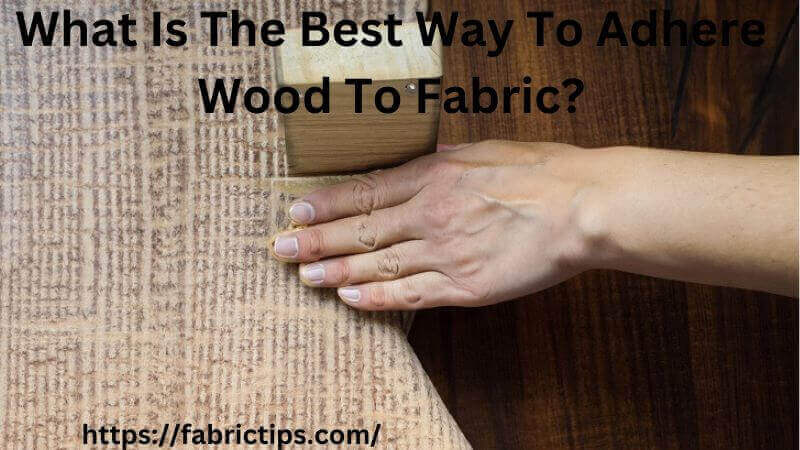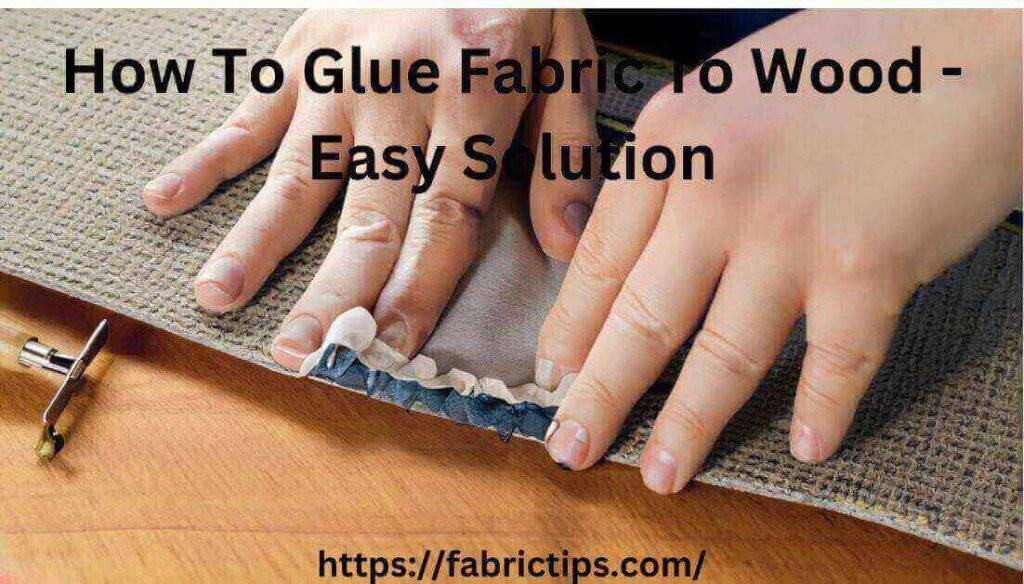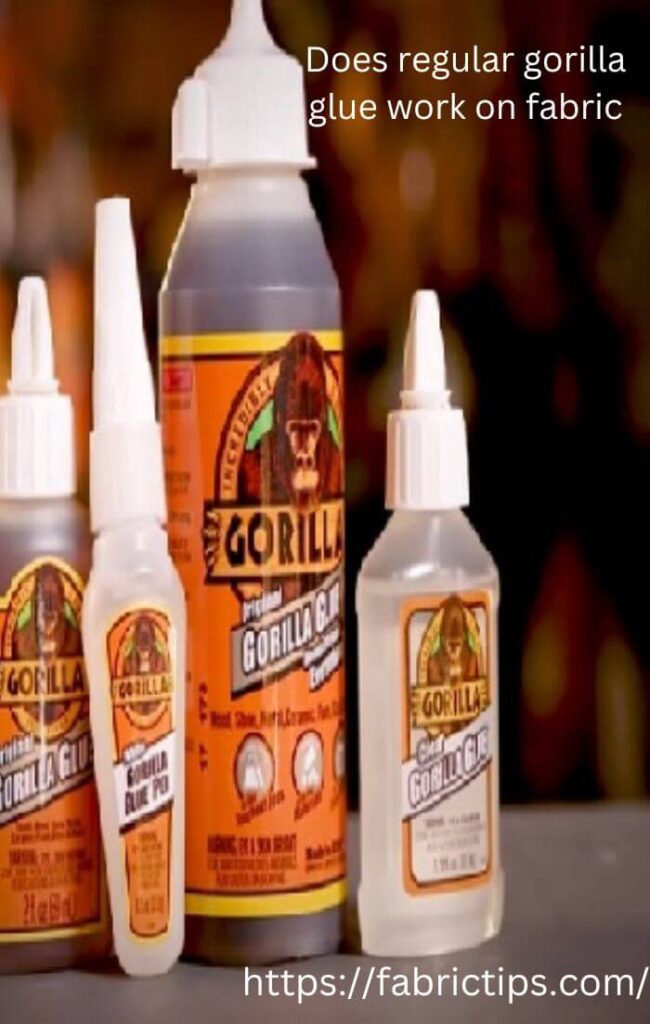Last Updated on November 3, 2023 by Wahid
By gluing fabric to wood, you can upcycle furniture or make your own personalized and unique items. Glue is the best method for attaching fabric to wood, but not only any glue will work.
This guide explains how to glue fabric to wood correctly because of this. At first, use fabric glue, which ensures that you will not damage the fabric during the affixing process. It’s also a good idea to sand and clean the wood surface first. After that, attach the material to the wood using glue.
In the following article, I’ll explain how to attach fabric to wood with the best glue. It will also be explained fabric and wood gluing permanently to prevent the fabric from peeling.
How To Glue Fabric To Wood: [Attention, Precaution, Experts Tips & Tricks]
Attention:
- Surface Preparation: Both the wood and fabric surfaces must be clean, dry, and free from any dust or oils. The wood surface should be smooth; sand it lightly if needed.
- Fabric Selection: Opt for fabric that isn’t too thick or textured, as this can hinder proper adhesion.
Precaution:
- Ventilation: Ensure you’re working in a well-ventilated area, especially if using strong adhesives that emit fumes.
- Protection: Wear gloves to prevent direct contact with the adhesive. Use protective sheets or newspapers to guard against accidental spills or drips.
Pro Guide:
- Cut The Fabric: Measure and cut the fabric to the desired size, adding a bit extra for potential adjustments.
- Choose The Right Adhesive:
- Spray Adhesive: Ideal for a smooth finish. Spray a thin, even layer on the wood, then press the fabric onto it.
- Mod Podge: Suitable for decoupage projects. Apply an even layer on the wood using a brush, lay the fabric over it, then brush another layer on top of the fabric.
- Fabric or Craft Glue: Good for smaller projects or detailed work. Spread evenly on the wood, then press the fabric onto it.
- Smooth Out Bubbles: Use a roller or your hands to smooth out the fabric, ensuring there are no bubbles or wrinkles.
- Secure With Clamps or Weights: This helps in ensuring a strong bond, especially for thicker fabrics or denser woods.
- Dry Completely: Check the adhesive’s instructions for drying time.
Expert Tips & Tricks:
- Test First: Before applying the adhesive to the entire project, do a small test patch to ensure compatibility between the fabric, wood, and glue.
- Thin, Even Layers: Apply adhesive in thin, even layers to avoid bubbling or seepage.
- Seal If Necessary: If your project will be exposed to moisture or frequent handling, consider sealing it with a clear acrylic sealer after the adhesive has dried.
- Trim Edges: Once the glue is dry, use a sharp knife or scissors to trim any excess fabric for a neat finish.
Yes, if you follow these guidelines and expert tips, you can effectively and seamlessly glue fabric to wood, ensuring a lasting bond and an aesthetically pleasing finish.
Fabric Can Be Glued To Wood – Is It Possible?

When you glue fabric to something with standard craft glue, they often don’t stick well, whether the surface is smooth or not. In materials like wood, the uneven surface can make fabrics stick harder.
- However, if the right glue is used, wood can adhere to the fabric. Glue designed for craft projects isn’t made to stick to fabric, and it might not work as well.
- If you want it to stick, you will have to use fabric glue. Nonetheless, it is necessary to prepare the wooden surface first in order to level it out.
- When the wood is sanded, it creates a smooth, flat surface that allows glue to adhere more easily.
- The wood must also be cleaned to remove any dirt or dust. Additionally, glue sticking can also be affected by this.
Next Read: 5 Easy & Best Way To Adhere Fabric To Wood.
What Is The Best Glue For Fabric To Wood?

Gluing fabric to wood is easy with “Mod Podge.” It comes in 8 ounces of transparent color.
- The original matte Mod Podge will work, but fabrics will benefit the most from Mod Podge made for fabrics.
- Additionally, Mod Podge is easy to use, as it can be brushed on without leaving a mess.
- In particular, if you’re refinishing items with fabric, it’s best to use Mod Podge. You’ll also get permanent results.
- Due to its ease of application, this is a great choice for adhering fabric to wood or large projects.
You know now how to Glue Fabric To Wood With Mod Podge and What Is The Best Glue For Fabric To Wood. However, if you want to know about How To Remove Hot Glue From Clothes: 7 Quick & Effective Methods waiting for you.
How To Glue Fabric To Wood With Mod Podge?

It is crucial to note that fabric gluing to wood requires more than just the correct glue. Preparing the wood is also important to ensure that Mod Podge adheres to both the fabric and the wood. Using Mod Podge to attach the fabric to wood is as simple as following these steps.
You’ll Need The Following Items Before We Begin:
- Microfiber cloth
- Fine grit sandpaper
- Scissors
- Measuring tape
- Foam paint brush
- Fabric
- Mod Podge
Sand The Wood
- Your first step will be to sand the wood using fine sandpaper, ideally between 100 and 200 grit.
- Make sure the surface is as smooth as possible before applying any finishes to the wood.
- Uneven surfaces or wood finishes can prevent the glue from sticking.
- Make sure the surface feels smooth by rubbing the sandpaper back & forth.
- After sanding, wipe off any dust generated by the sanding process with a paper towel.
Clean The Wood
- Now, you’ll need to scrub the wood clean of any dirt, oils, or dust left over from sanding.
- After that, use a microfiber cloth to dust off the wood.
- Then, wring out the excess water from the cloth and dampen it.
- Make sure you do not overwet the cloth because this will make the wood take more time to dry.
- Once the wood surface has been cleaned, wipe it with a rag.
Let The Wood Dry
- Once you have cleaned the wood, let it dry thoroughly before using it.
- A wet surface might prevent the glue from sticking.
- Wood dries depending on the amount of water on the rag and the amount you wipe it with.
- Depending on the type of product, it may dry in as little as an hour, or it may require several hours.
Measure & Cut Fabric
Upon drying the wood, prepare your fabric by measuring and cutting it. Make sure you do this before using Mod Podge. In this way, after applying the Mod Podge, the fabric can be stuck to the surface.
Measurement of fabric can be done in two ways.
- First, measure the wood with a measuring tape and transfer the dimensions to the fabric as needed.
- Second, the fabric is placed directly over the wood so that the inside is facing out. Mark the spot where the cuts need to be made with a pencil. Regardless of how you are measuring the fabric, adding one inch to all measurements is a good idea. Doing so will ensure that there is enough fabric for covering the clothes even if you mistakenly measure or cut them incorrectly.
- Finally, cut your fabric according to your ideal measurements.
Apply Mod Podge
- You should apply Mod Podge around the wood using the foam brush, first starting at the outer edges & work your way inwards.
- Since Mod Podge dries quickly, the outside of the wood will be more convenient to apply it to than the middle after the fabric is attached.
- This is another reason why you should measure & cut your desired fabric before using Mod Podge.
Glue The Fabric To Wood
Mod Podge is applied as follows:
- The fabric should be laid flat across the wooden surface and aligned as precisely as possible.
- When you leave some extra inch of fabric between each side, do not forget that your fabric will go over the wood sides.
- The fabric should be gently pressed against the wood.
- Make sure that wrinkles are smoothed out with your fingers or by using a roller.
- Then, press the fabric firmly to ensure that the glue adheres to it.
- Be sure to put more Mod Podge on the corners & edges under the garment if necessary.
Let It Dry
- Despite Mod Podge’s ability to dry relatively quickly, overnight drying is recommended for the best results.
- In addition, this will let you know if the fabric is attached correctly to the wooden base.
- Ensure that the corners & edges are lifted, particularly to ensure that the items are well attached.
- Even if they can still be lifted after the Mod Podge has dried overnight, additional Mod Podge may still be needed.
Remove Excess Fabric
- When the Mod Podge is dry and the edges and corners are attached, make sure that all excess fabric is trimmed off.
- It is important to ensure that the fabric is properly glued onto the wood.
- If you cut cleanly, it is possible to get a good result.
How To Temporarily Attach Fabric To Wood?

Attaching fabric to wood with Mod Podge is one of the most permanent methods. However, if you fail to do it correctly, the results will not be as long-lasting as they should be. However, if you have no way to permanently attach the material to wood, it can be temporarily glued until you find a more permanent solution.
Hot Glue
Hot glue is the best method for temporarily attaching fabric to wooden surfaces, especially when the wood has been finished. As hot glue adheres less strongly to finished wood, it will be easier to take off when you’re done. Additionally, the wood shouldn’t be damaged.
Unfinished wood can adhere better to hot glue, however, it won’t hold up quite as well as “Mod Podge Plus.“ If hot glue sticks to the surface, rub it with alcohol until it is separated from the wood.
Double-Sided Tape
It is also possible to temporarily fix fabrics to wood with double-sided tape. The fabric can be easily removed without damaging the wood when pulled out. However, if you’re applying double-sided tape to wood, it is important to take some precautions.
When the tape is left on an object for a long time, it becomes more adhesive and more difficult to remove. Due to this, the fabric and wood may leave sticky residue behind.
Depending on whether the wood is stained or painted, some stains or treatments may be pulled off by the tape. Leaving the product on for an extended period will cause this. Even though the tape won’t damage fabric except by leaving adhesive behind, temporarily covering wood could result in unsightly markings.
Velcro
Velcro can also be used to temporarily attach the fabric to wood. If you would like to switch out the fabric on wood surfaces, this is a great method to use. Hooked velcro goes on the furniture, and looped velcro goes on the fabric.
Attach it simply by sticking it on. Then again, there are some things to think about when using double-sided tape. To begin with, like tape, Velcro can leave traces of adhesive in fabrics & wood after being removed, especially after long-term use.
Also, wood surfaces can be removed from their paint or polish with this tool. Using Velcro to switch out fabrics for woodwork is possible, but you may have to loop Velcro onto each new fabric piece. This is why you attach the hook to the wood.
Over time, the looped portion usually wears down and loses texture. In addition, if you attempt to eliminate it, you may find that it does not adhere to another fabric.
Can Hot Glue Be Used To Glue Fabric To Wood?

Fabric can be attached to wood with hot glue from a glue gun. However, various glue guns work with different types of hot glue, and you should use suitable glue.
The typical glue guns melt glue at high temperatures. There are also lower-temperature glue guns, the temperature of which is much lower than normal glue guns.
Temperature-adjustable glue guns are also available. When applying hot glue to fabric, low-temperature glue guns work best. By using a glue gun at high temperatures, hot glue may burn right through your fabric.
Low-temperature glue guns don’t get hot enough to damage the fabric. To ensure that they will melt, use hot glue sticks that melt at low temperatures.
Low-temperature glues may not produce the strongest bond between wood and fabric because they don’t get hot enough. Additionally, even if the wood is prepared properly, it may not stick.
Therefore, hot glue works well when it comes to small projects and for projects that don’t require strong adhesion. Attaching fabric to wood furniture shouldn’t be done with hot glue, due to the glue’s short-term durability.
Can Gorilla Glue Be Used To Glue Fabric To Wood?

Gorilla Glue is also useful for gluing fabric to wood. The problem is, any type of old Gorilla Glue won’t work. Instead, use Gorilla Glue which is specially formulated for fabrics. Even though Gorilla Glue can glue clothing to wood, you should not use it on large projects.
As a starter, it could be quite messy and the process isn’t as simple as Mod Podge. However, Gorilla Glue for fabrics has a smaller package size than Mod Podge. Attaching fabric to a large piece of wood will use much more Gorilla Glue. Therefore, use it only for small projects such as attaching fabric to small pieces, not to attach cloth to furniture.
How To Attach Fabric To Wood?

Using a fastener, typically staples and flat-headed fabric nails, gives you the best results in joining wood and fabric.
In some cases, this won’t work, particularly if you plan on connecting them to something that will be visible. Certain circumstances require gluing them together. You won’t be able to use any glue. It is noticeable when some discolor the fabric after they seep in.
What Is The Best Way To Adhere Wood To Fabric?

Make sure the wood is sanded before gluing. Preparation, concentration, & the right adhesive are key to successfully gluing wood & fabric together. When this happens, wood is usually the fixed point. Whenever you merge the two, the cloth won’t remain in its original shape, so you’ll have to keep it under control.
However, the wood needs to be sanded with 100 grit sandpaper before you begin. In this way, the surface will remain smooth & free from defects that would detract from the appearance of the end product.
After sanding, wipe the surface with a paper towel or damp cloth to remove any dust or little wood chips that fell off. It is not advisable to bond the fabric to sawdust; the fabric should be attached to wood instead.
After the wood has been prepared, the adhesive is applied. Adhesives such as Mod Podge are widely used. Due to its versatility, it can be attached to both fabrics and woods. Additionally, the fabric can be sealed with it. Mod Podge works best when applied with a foam brush.
How To Use Fabric Spray Adhesive?

Fabric specific spray adhesives are another popular option. The uniform application of these products makes them great. Avoid letting glue collect on your wood, which will result in an inconsistent fabric-to-wood connection.
- Glue the wood on a thin, smooth layer once the fabric and wood are bonded.
- Place your cloth over the wood with as much precision as possible.
- There will be time for you to modify, however, make sure you get the adhesive exactly right as you can during the initial application to avoid uneven drying.
- Then, use your fingertips to smooth any wrinkles.
- Due to the rapid cure of the glue, work quickly.
- To complete the drying process, let it rest for at least 24 hours.
- After you have finished, trim away any extra fabric.
Is Wood Glue Or Gorilla Glue Better For Gluing Wood?
Both wood glue and Gorilla Glue are effective for bonding wood, but their suitability depends on the specific project and conditions.
Wood Glue (PVA-based, like Elmer’s Glue or Titebond Glue):
Advantages: Dries clear or yellowish, making it less noticeable on wood projects. It’s sandable and can be stained over, making it popular for woodworking where appearance matters. It also offers a strong bond for wood-to-wood connections.
Disadvantages: Not waterproof, so it’s unsuitable for outdoor projects unless you’re using a type specifically formulated to be water-resistant.
Gorilla Glue (Polyurethane-based):
Advantages: Waterproof and versatile, it can bond various materials, including wood, stone, metal, and ceramics. It expands while drying, filling gaps.
Disadvantages: Expansion can be problematic if not clamped correctly. It dries brown and can be harder to sand. Excess squeeze-out can be messy and more noticeable.
For most indoor woodworking projects where appearance is crucial, wood glue is often the preferred choice due to its finish-friendly properties. For outdoor projects or applications needing water resistance or where multiple materials are involved, Gorilla Glue is typically better. Proper surface preparation and clamping are essential for both to achieve optimal bond strength.
Commonly Asked Questions From “Quora”
01. Can I use Elmer’s glue to glue fabric onto cardboard?
” You can use Elmer’s Glue on cardboard, but it is not the best choice. Problem with Elmer’s is that it is water based, and water softens cardboard, and is slow to dry, and often wrinkles remain. I suggest the “hot glue / glue gun system” for this type of bonding with fabric. H/glue hardens or cures very quickly. It will stick to cardboard and fabric. You will be able to work much faster with your project. “
“Robert Hixson”
” Yes, you can use Elmer’s Glue for your project. However, there are glues made for use with fabrics. Some of the Aleene’s glues might be better used here.”
“Carolyn Moore”
” You can use Elmer’s glue to adhere lightweight and porous fabrics like cotton to cardboard by applying a thin, even layer of glue to the cardboard, pressing the fabric onto the glued surface, and allowing it to dry completely. While this method is suitable for many craft projects, consider using specialized fabric glue or craft adhesives for more robust and long-lasting bonds or when the project may be exposed to moisture or frequent handling. Proper surface preparation and attention to edges and corners are essential for a successful fabric-to-cardboard bond. “
“Sayan Ganguly”
02. Does Super Glue work on cardboard?
” Sure, Super Glue will work. The advantage is, used properly, it is a quick setting. It tends to be brittle. Small joints will lack strength. If speed or holding in position is not an issue, there are cheaper, more flexible alternatives. “
“Daniel Debenedetto”
” Sure. It works on toilet paper too. It soaks in and sets up pretty quickly, so you should have your parts in position before applying the liquid. Or, use the thick gel type and assemble quickly. The set glue saturated paper is stronger than the surrounding paper. “
“Dennis Pasek”
03. What is the best glue for fabric and why?
” I prefer Liquid Fusion over Fabric Fusion; both made by Aleene’s. Liquid Fusion can be applied without much bleeding. The Urethane formula has made it through many mechanical washings/heat drying without degrading the bond. Otherwise, the old gold standard is heavy duty ‘Stitch Witchery’ fusible tape, made of polyamide polymer webbing. “Heat and press’ ‘ process is needed to set the glue. It doesn’t bleed through. I recommend you use double thickness of stitch witchery for best results. “
“Stuart Lew”
04. What kind of glue can you use instead of wood glue?
” Polyvinyl acetate, or PVA for short and basically what wood glue is. It is waterproof when hardened, dries clear and brushes wash out in water just the same but may take longer to dry as some pva wood glues are fast set. Standard pva is used as a bonding agent in construction with masonry products and as a sealer but normally diluted with water. “
“Adrian Bew”
” Wood glues fall into several categories. Organic glues:- hide glue, fish glue, Calcium caseinate and blood albumin. Inorganic adhesives can be thermoplastic like the PVA range and the thermosetting types like urea, phenol, resorcinol formaldehydes and polyurethanes. All these products are used for sticking wood to wood and wood to other materials. ”
“David Starling”
A Final Note
Furniture is commonly made using fabric-to-wood adhesives. My discussion covered all possible methods for how to glue fabric to wood. Adding fabric to wood can provide a permanent or temporary update on the appearance of wood furniture or other wood items. In order to ensure a permanent adhesion, sand and clean the wood before applying Mod Podge. However, if you need something temporary, you can do so as well. If you find value in this article, please comment and share it. Thank you for reading!


